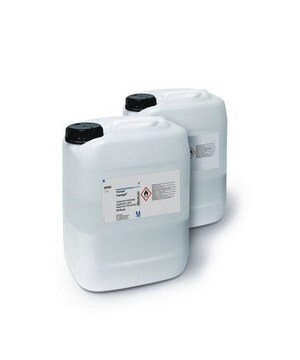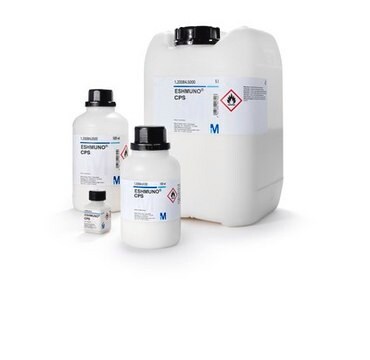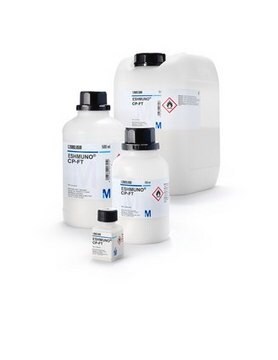1.16890
Fractogel® EMD SO₃⁻ (S)
Synonym(e):
Fractogel® EMD SO3⁻ (S) Harz
About This Item
Empfohlene Produkte
ligand
(Sulfoisobutyl)
Qualitätsniveau
100
400
Beschreibung
strong cation exchanger, suspension in 20% ethanol and 150 mM NaCl (20-40 µm)
Sterilität
sterile (Caustic Stable)
Assay
≥90% (HPLC)
Form
resin
Hersteller/Markenname
Calbiochem®
Parameter
8 bar max. pressure
80 cm/hr flow rate
Aktive Matrixgruppe
methacrylate
Mittlere Partikelgröße
20-40 um μm
Kapazität
150 mg binding capacity (lysozyme/ml of resin)
Übergangstemp.
flash point 35 °C (Does not sustain combustion.)
Dichte
1.43 g/cm3 at 20 °C
Schüttdichte
1000 kg/m3
Trenntechnik
strong cation exchange
Versandbedingung
ambient
Lagertemp.
2-8°C
Suchen Sie nach ähnlichen Produkten? Aufrufen Leitfaden zum Produktvergleich
Verpackung
- 1.16882.0100: Fractogel® EMD SO3- (S) Harz 100 ml
- 1.16882.0010: Fractogel® EMD SO3- (S) Harz 10ml
- 1.16882.0500: Fractogel® EMD SO3- (S) Harz 500ml
- 1.16882.5000: Fractogel® EMD SO3- (S) Harz 5 l
Warnhinweis
Hinweis zur Analyse
Mikroskopische Beurteilung: Einheitliche kugelförmige Partikel, keine Agglomerate, keine Feinanteile
Auswaschbare Anteile (Wasser): ≤ 0,05 %
Cer: ≤ 10 µg/g
Druckabfall (Säule: ID=1,6 cm, L=10 cm bei 5 ml/min): ≤ 5,0 bar
Teilchengröße (d10): 20–28 µm
Teilchengröße (d50): 24–34 µm
Teilchengröße (d90): 28–38 µm
Koloniebildende Einheiten (TAMC + TYMC): ≤ 100 KBE/ml
Endotoxine: ≤ 1,00 EE/ml
Proteinbindungskapazität (Lysozym): 120–180 mg/ml
Funktionstest (c:d): ≤ 0,15
Funktionstest (b:a): ≤ 0,15
Funktionstest: Trennung Chymotrypsinogen A, Cytochrom c und Lysozym
Rechtliche Hinweise
Signalwort
Warning
H-Sätze
Gefahreneinstufungen
Flam. Liq. 3
Lagerklassenschlüssel
3 - Flammable liquids
WGK
WGK 1
Flammpunkt (°F)
95.0 °F
Flammpunkt (°C)
35 °C
Analysenzertifikate (COA)
Suchen Sie nach Analysenzertifikate (COA), indem Sie die Lot-/Chargennummer des Produkts eingeben. Lot- und Chargennummern sind auf dem Produktetikett hinter den Wörtern ‘Lot’ oder ‘Batch’ (Lot oder Charge) zu finden.
Besitzen Sie dieses Produkt bereits?
In der Dokumentenbibliothek finden Sie die Dokumentation zu den Produkten, die Sie kürzlich erworben haben.
Unser Team von Wissenschaftlern verfügt über Erfahrung in allen Forschungsbereichen einschließlich Life Science, Materialwissenschaften, chemischer Synthese, Chromatographie, Analytik und vielen mehr..
Setzen Sie sich mit dem technischen Dienst in Verbindung.



